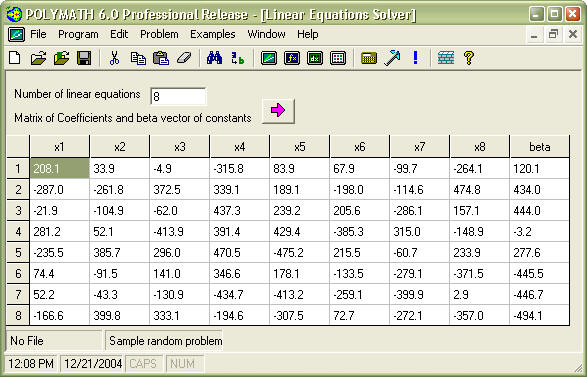

The top and bottom equations look right: the top has 4w and the bottom has -2w, so if I multiply the bottom equation (both sides!) by -2, I get a new fourth equation: Here's an example with "elimination": I decide I want to eliminate the "w", so I look at the four equations and I choose two where I can see that the factor of w in one is an easy multiply of the factor of w in the other, then I multiply one of the equations in order to make the factors identical. The idea is to combine the equations in order to reduce the number of variables. You have four equations and four unknowns, so I expect that you'll be able to find the solution using regular "simultaneous equation" solving methods, such as substitution and elimination. Once a professor taught me a very important rule: When you have n unknowns, you need at least n equations to solve for all of them. Help in solving this question or maybe a proper method of approaching gaussian elimination. Hi, Im' Johan from Malaysia and I'm doing my first year engineering degree. X = np.linalg.solve(A, np.ones((2 * (n - 1),)))įor M(2) when n=3, which is not what you came up with.Solving four simultaneous equations - Math Central This is messy, but solves your problem, barring a very probable mistake transcribing the coefficients: from _future_ import division from sympy import Integer, Symbol, Eq, solve It's not fast, but it allows me to copy the RHS of your equations exactly, limiting the thinking I need to do (always a plus), and gives fractional answers. Here's an entirely different approach, using sympy. Return spsolve(coeff_mat.tocsr(), const).reshape((-1,1)) Solution using scipy.sparse: from scipy.sparse import spdiags, lil_matrix, vstack, hstack Implementation using numpy: import numpy as np
#Simultaneous equation solver code#
This is not reflected in the spreadsheet above but has been implemented in the code below: the row (= eq.) has been derived:Īs Jaime suggested, multiplying by n improves the code. The first column show from which of the above given eqs. The sought after solution vector x is here light green and used to label the columns. The coefficient matrix A is light blue, the constant right side is orange. Here's a snapshot for the example case n=50 showing how you can derive the coefficient matrix and understand the block structure. Then I build up the A-coefficient matrix from 4 block matrices. Here I ordered the equations such that x is N_max.,N_0,M_max.,M_1. The linear system to solve is of the shape A dot x = const 1-vector. This gives the solution in the order N_max.,N_0,M_max.,M_1.

Updated: added implementation using scipy.sparse Posted follow up to Using scipy sparse matrices to solve system of equations.
#Simultaneous equation solver update#
Update The answers are great but they use dense solvers where the system of equations is sparse. If I want to plug in n=50, say, how can you set up this system of simultaneous equations in python so that can solve them?

This is because the equations become M(1) = 1+(2/2)*N(0) For example, when n=2 the answer should be M(1) = 4, I believe. I actually only want the value of M(n-1). I have been using Maple but I would like to set these up and solve them in python now, maybe using (or any other better method). Notice also that p is just a constant integer in every equation so the whole system is linear. For a fixed integer n, I have a set of 2(n-1) simultaneous equations as follows.


 0 kommentar(er)
0 kommentar(er)
